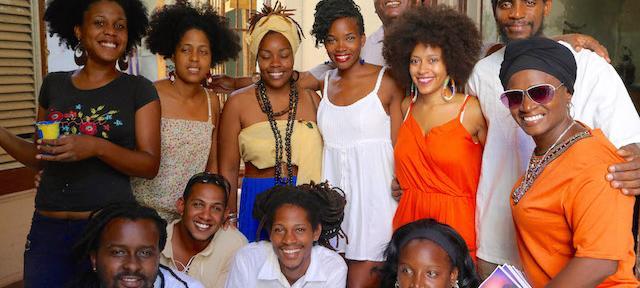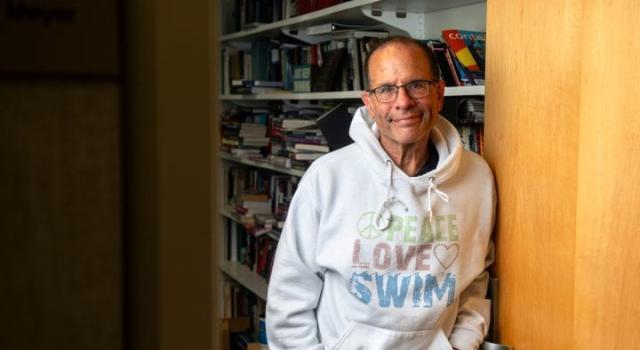Troncoso's International Exhibit and Capstone Research Celebrate Blackness in Cuba

During Aurelis Troncoso’s second study-abroad trip with the Hampshire in Cuba program, she was talking with the curator Diarenis Calderon Tartabull and made an off-hand comment that she never expected would launch a project that would transform her college experience.
“I realized that, over the duration of two semesters in Cuba, I had connected with all these amazing activists, artists, and rappers," Troncoso remembers. “I joked to my friend that it would be great if we could showcase them with an exhibition of all our friends’ works and celebrate blackness in Cuba. She looked at me, and said, ‘Well, what are we waiting for? Let’s plan it!’”
That’s how Troncoso’s second trip to Cuba paved the way for a third—when she would actually premiere the exhibit for the public.
To help fund her work, Troncoso, a James Baldwin Scholar, received grants from both the James Baldwin Scholars Division II and Division III internship grant and the Ethics and the Common Good (ECG) program. Troncoso was the recipient of one of the first ECG summer internship grants, which fund ethically-informed student projects aimed at serving the common good.
The idea of the exhibit was to build a transnational bridge between artists of African descent in Cuba and the United States and overall artists of African descent, says Troncoso, who co-curated the exhibit.
Putting the show together had its difficulties, among them simply finding a gallery space to reserve, as the Havana Art Biennial would be going on at the same time as the exhibit in summer, 2015. And even with the funding secured, the reality of Cuba’s economy made it a challenge to find certain resources, such as the paint needed so the artists could collaborate on a mural. And they searched for weeks for a scaffold to rent.
The Hampshire in Cuba Program that brought Troncoso to that country enables students to spend a semester living with a Cuban family and studying and working with peers and tutors from Fundación Alejo Carpentier. They design their own course of study while also studying Spanish, taking a seminar in contemporary issues in Cuban arts and society, and completing an individualized project with tutors that will count toward their Division II or III requirement.
Eventually, Troncoso said, she procured the resources she needed to stage the exhibit. Donations starting coming in, such as paintbrushes from one of the exhibit partners, the Caribbean Cultural Center African Diaspora Institute in Harlem, where Troncoso had interned the summer before.
In May, 2015, Troncoso premiered her exhibit “Addimú pa’ mi” in Cuba, featuring five Cuban artists and focusing on neo-African art. The show celebrated blackness and connection to African diaspora from each artist’s perspective. One artist, for example, depicted the Yoruba pantheon of Orishas (deities in Regla de Ocha-Ifá); another represented “black womxn as culture bearers and nurturers of the world.”
Troncoso intends to bring the exhibit to cities such as New York, New Orleans, and Miami. “I want to own up to my word,” she says. “That’s one of the most important things—to redistribute your resources ethically when you have access to a specific amount of them. That goes back to the Ethics and the Common Good program’s main point: how do we have an impact on these communities we’re trying to build, mobilize, or help?”
The curatorial theme of the exhibit is very much connected to Troncoso’s Division III research project which she is undertaking now as her capstone in her fourth year at Hampshire. The project, “La Rebelión de las Shangós: The Resistance of Black Cuban Womxn in Regla de Ocha-Ifá,” comes as a direct result of her time in Cuba. In it, she studies the empowerment and resistance of black Cuban women in the Santería religion (also known as Regla de Ocha-Ifá).
“Highlighting the African diasporic womxn’s experience is really important for me,” says Troncoso, who began looking into the experiences of Afro-Cubans within Santería after reading an anthology of Afro-Cuban women’s experiences recommended by Professor of Sociology Margaret Cerullo, coordinator of the Hampshire in Cuba program.
Troncoso’s tutor in Cuba, the ethnomusicologist and Afro-Cuban culture scholar Cary Diez, also influenced her decision to focus her studies on black Cuban women. The research she undertook in Cuba helped her not only to understand a culture, but also to form deep ties with the communities and people she spoke with.
“The most rewarding parts of the program are the connections I built, the relationships I cultivated,” says Troncoso, “and the fact that I can say ‘Yes, I put on this exhibition, this international exhibition, at the age of twenty-two.’”




